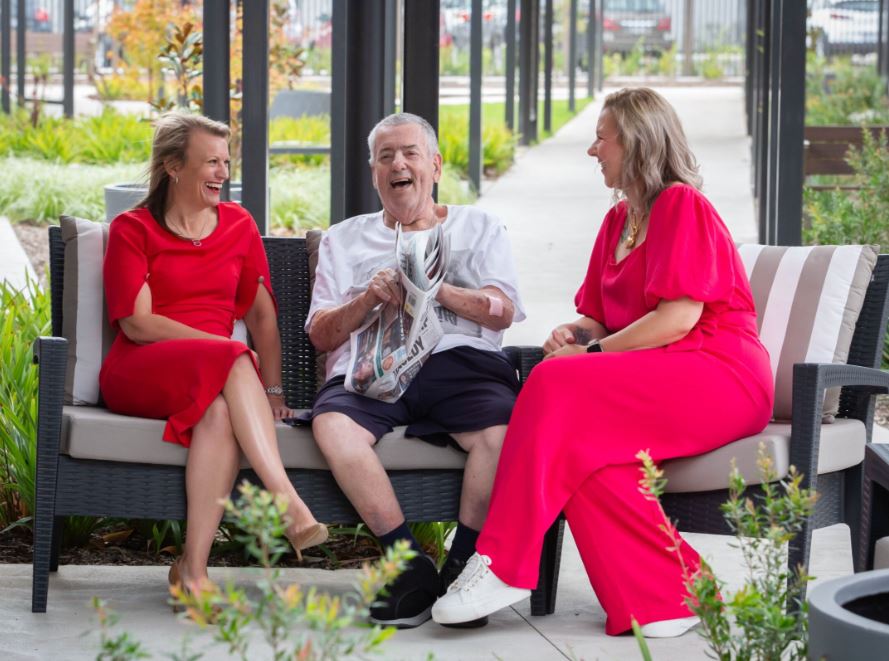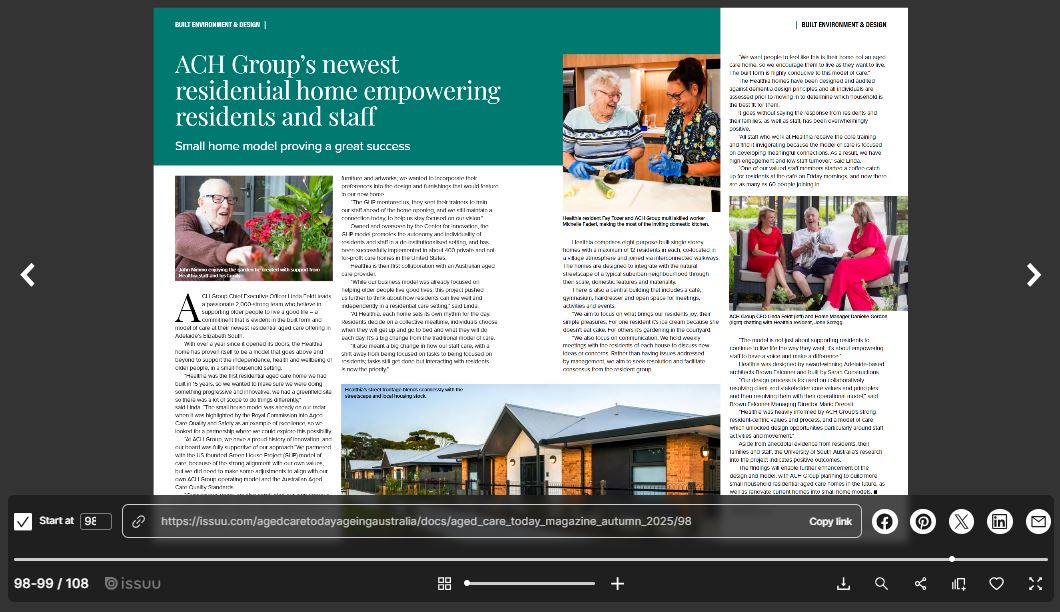As seen in Aged Care Today – Small home model proving a great success
We are delighted to announce that the innovative achievements at Healthia, ACH Group’s newest residential aged care home, have been highlighted in Aged Care Today magazine. Healthia showcases how a pioneering approach can support both residents and staff to thrive, with a model designed to enhance independence, connection, and quality of life.
Aged Care Today is the highly regarded magazine published by Ageing Australia for the aged care sector. Read the article online.
.
ACH Group’s newest residential home empowering residents and staff
Partnership with US model a great success
ACH Group CEO Linda Feldt leads a passionate 2,000-strong team who believe in supporting older people to live a good life – a commitment that is evident in the built form and model of care at their newest residential aged care offering in Adelaide’s Elizabeth South.
With over a year since it opened its doors, the Healthia home has proven itself to be a model that goes above and beyond to support the independence, health and wellbeing of older people, in a small household setting.
“Healthia was the first residential aged care home we had built in 15 years, so we wanted to make sure we were doing something progressive and innovative; we had a greenfield site so there was a lot of scope to do things differently,” said Linda.
“The small house model was already on our radar when it was highlighted by the Royal Commission into Aged Care Quality and Safety as an example of excellence, so we looked for a partnership where we could explore this possibility.
“At ACH Group, we have a proud history of innovation, and our board was fully supportive of our approach.
“We partnered with the US-founded Green House Project (GHP) model of care, because of the strong alignment with our own values, but we did do some tweaking based on our Aged Care Quality Standards.
“Over several years, we also conducted our own rigorous consumer consultation, with the help of COTA Australia. We consulted our current residents in relation to furniture selection and artworks; we wanted to understand their needs and preferences.
“The GHP mentored us , they sent their trainers to train our staff ahead of the home opening, and we still maintain a connection today, to help us stay focused on our vision.”
Owned and overseen by the Center for Innovation, the GHP model promotes the autonomy and individuality of residents and staff in a de-institutionalised setting, and has been successfully implemented in about 400 private and not-for-profit care homes in the United States.
Healthia is their first collaboration with an Australian aged care provider.
“While our business model was already focused on helping older people live good lives, this project pushed us further to think about how residents can live independently in a residential care setting,” said Linda.
“At Healthia, each home sets its own rhythm for the day. Residents decide on a collective meal time, individuals choose when they will get up and go to bed and what they will do each day. It’s a big change from the traditional model of care.
“It also meant a big change in how our staff care, with a shift away from being focused on tasks to being focused on residents; tasks sill get done but interacting with residents is now the priority.”
Healthia comprises eight purpose-built single storey homes with a maximum of 12 residents in each, co-located in a village atmosphere and joined via interconnected walkways. The homes are designed to integrate with the natural streetscape of a typical suburban neighbourhood through their scale, domestic features and materiality.
There is also a central building that includes a café, gymnasium, hairdresser and open space for meetings, activities and events.
“We aim to focus on what brings our residents joy, their simple pleasures. For one resident it’s ice cream because she doesn’t eat cake. For others it’s gardening in the courtyard.
“We also focus on communication. We hold weekly meetings with the residents of each house to discuss new ideas or concerns.
“At one home, the vegetable seedlings were being eaten by birds, so at the weekly meeting they decided to build a scarecrow, but then one resident didn’t like it outside her window, so it was moved to another resident’s window, who didn’t mind.
“We want people to feel like this is their home not an aged care home, so we encourage them to live as they want to live. The built form is highly conducive to this model of care.”
Individuals are assessed prior to moving in, to determine which household is the best fit, and with each of the homes audited against dementia design principles, people living with dementia are encouraged to apply.
It goes without saying the response from residents and their families, as well as staff, has been overwhelmingly positive.
“All staff who work at Healthia receive the core training and find it invigorating because the model of care is focused on developing meaningful connections. As a result, we have high engagement and low staff turnover,” said Linda.
“One of our staff members started a coffee catch up for residents at the café on Friday mornings, and now there are as many as 60 people joining in.
“The model is not just about supporting residents to continue to live life the way they want; it’s about empowering staff to have a voice and make a difference.”
Aside from anecdotal evidence from residents, their families and staff, the University of South Australia’s research into the project indicates positive outcomes.
The findings will enable further enhancement of the design and model, with ACH Group planning to build more small household residential aged care homes in the future, as well as renovate current homes to sit on a par with greenfield sites.

